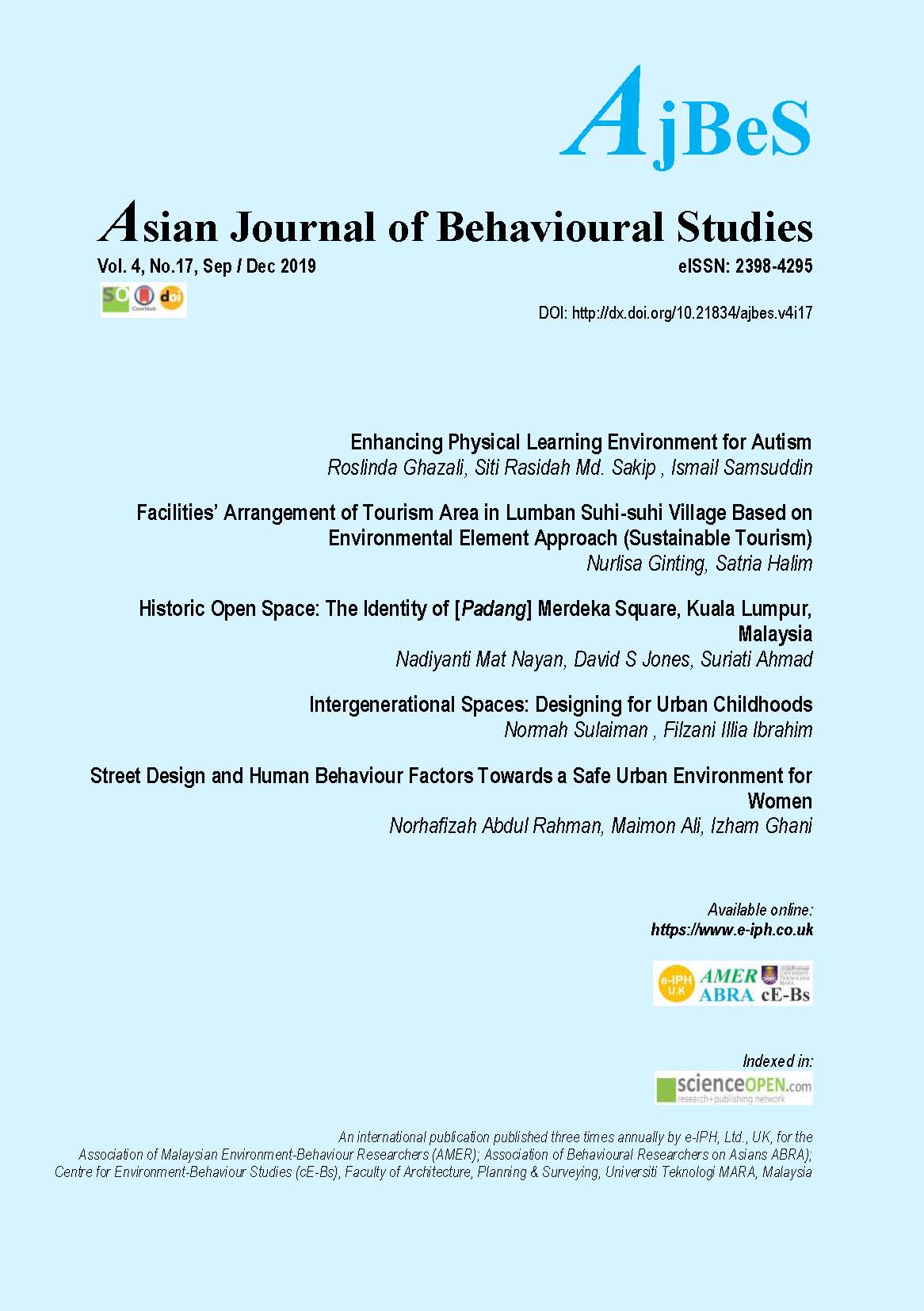Street Design and Human Behaviour Factors towards a Safe Urban Environment for Women
DOI:
https://doi.org/10.21834/ajbes.v4i17.184Keywords:
women safety, urban design, safe cities, behavioural studyAbstract

Integrating women safety in the urban street environment is critical in creating good quality living to improve living standard. This paper discusses women’s needs and characteristics of urban streets that can affect women’s behaviour. The objectives of this paper are to identify the characters of urban environment in making streets safe for women and establishing the characteristics of safe urban street environment for women. This study is conducted using mixed methodology to identify the relationship between urban street design and women’s behaviour. This paper will contribute towards safe urban street design with an excellent urban environment and dynamic economic activities.Â
Keywords: women safety; urban design; safe cities; behavioural studyÂ
eISSN: 2398-4295 © 2019. The Authors. Published for AMER, ABRA & cE-Bs by e-International Publishing House, Ltd., UK. This is an open access article under the CC BY-NC-ND license (http://creativecommons.org/licenses/by-nc-nd/4.0/). Peer–review under responsibility of AMER (Association of Malaysian Environment-Behaviour Researchers), ABRA (Association of Behavioural Researchers on Asians) and cE-Bs (Centre for Environment-Behaviour Studies), Faculty of Architecture, Planning & Surveying, Universiti Teknologi MARA, Malaysia.
References
Burton, E., & Mitchell, L. (2006). Inclusive Urban Design: Streets for life. UK: Architectural Press.
Davies, L. (2000). Urban Design Compendium. English Partnership UK.
Ehrenfeucht, R. & Loukaitou-Sideris, A. (2010). Planning Urban Sidewalks: Infrastructure, Daily Life and Destinations. Journal of Urban Design, 14( 4), 459-471.
Gehl, J. (2010). Cities for People. London: Island Press.
Jacobs, A. B. (1996). Great Streets. Cambridge, Massachusetts: The MIT Press.
Krupart, E. (1985). People in Cities: The Urban Environment and its Effects. New York: Cambridge University Press.
Loukaitou-Sideris, A. (1995). Urban Form and Social Context: Cultural Differentiation in the Uses of Urban Parks. Journal of Planning Education and Research, 14, 89-102.
Lynch, K., 1984. Good City Form. Cambridge, Massachusetts: The MIT Press.
Mehta, V. (2009). Look Closely and You Will See, Listen Carefully and You Will Hear: Urban Design and Social Interaction on Streets. Journal of Urban Design, 14(1), 29-64.
Mehta, V. (2013). The Street: A Quintessential Social Public Space. Routledge.
Rahman, N. A., Ghani, I., Bahaluddin, A., & Hussain, N. H. (2018). Creating Good Social Behaviour through User-friendly Street Environment. Asian Journal of Quality of Life (AjQoL), 3(12), 51-60.
Rahman, N. A., Md Sakip, S. R., & Mat Nayan, N. (2018). A User-Friendly Shopping Street. Asian Journal of Quality of Life (AjQoL), 3(10), 1-8.
Rahman, N. A., Md Sakip, S. R., & Mat Nayan, N. (2016). Physical Qualities and Activities for a User-friendly Shopping Street in the Context of a Malaysian City. Procedia - Social and Behavioural Sciences, 222, 196-202.
Rahman, N. A., Shamsuddin, S., & Ghani, I. (2018). Factors Determining Usability of the Streets. Asian Journal of Behavioural Studies (AjBeS), 3(12), 73-80.
Rahman, N. A., Shamsuddin, S., & Ghani, I. (2015). What Makes People Use the Street?: Towards a Liveable Urban Environment in Kuala Lumpur City Centre. Procedia - Social and Behavioural Sciences, 170, 624-632.
SIRIM, 1993. MS 1331:1993- Code of Practice for Access for Disabled People Outside Buildings (1993): Department of Standards Malaysia.
Sisiopiku, V. P. & AKin, D. (2003). Pedestrian Behaviors at and Perceptions Towards Various Pedestrian Facilities: An Examination Based on Observation and Survey Data, Transportation Research Part F 6 (2003), 249-274.
Tonkiss, F. (2005). Space, the City and Social Theory: Social Relations and Urban Forms. UK: Polity Press.
Ujang. N (2012). Place Attachment and Continuity of Urban Place Identity. Procedia-Social and Behavioural Sciences, 49, 156-167.
Whyte, W. H. (1980). The Social Life of Small Urban Spaces. Washington, D.C.: The Conservation Foundation.
Bishop, K., & Said, I., (2017). Challenges of Participatory Qualitative Research in a Malaysian and Australian Hospital. Asian Journal of Environment-Behaviour Studies, 2(4), 1-11.

